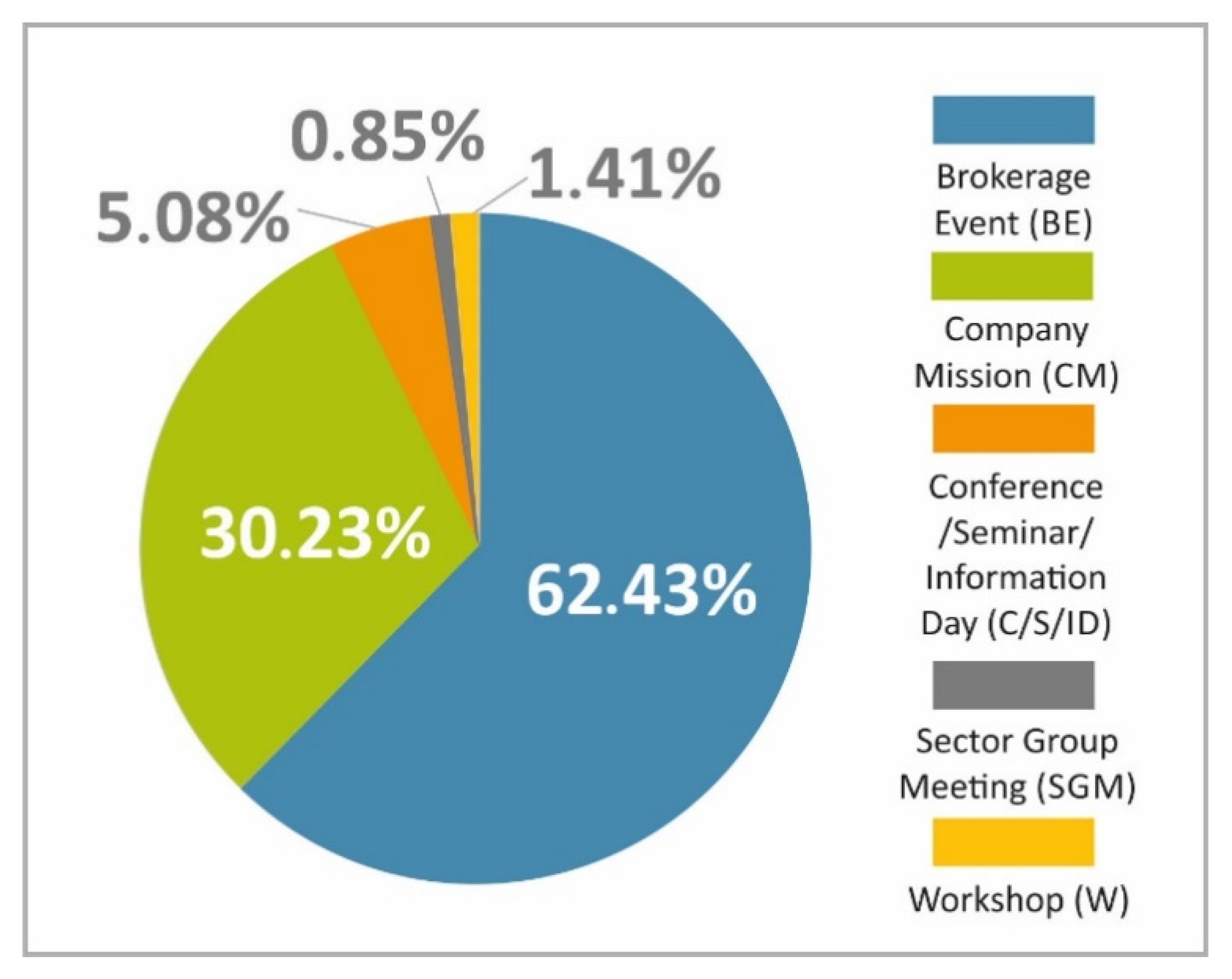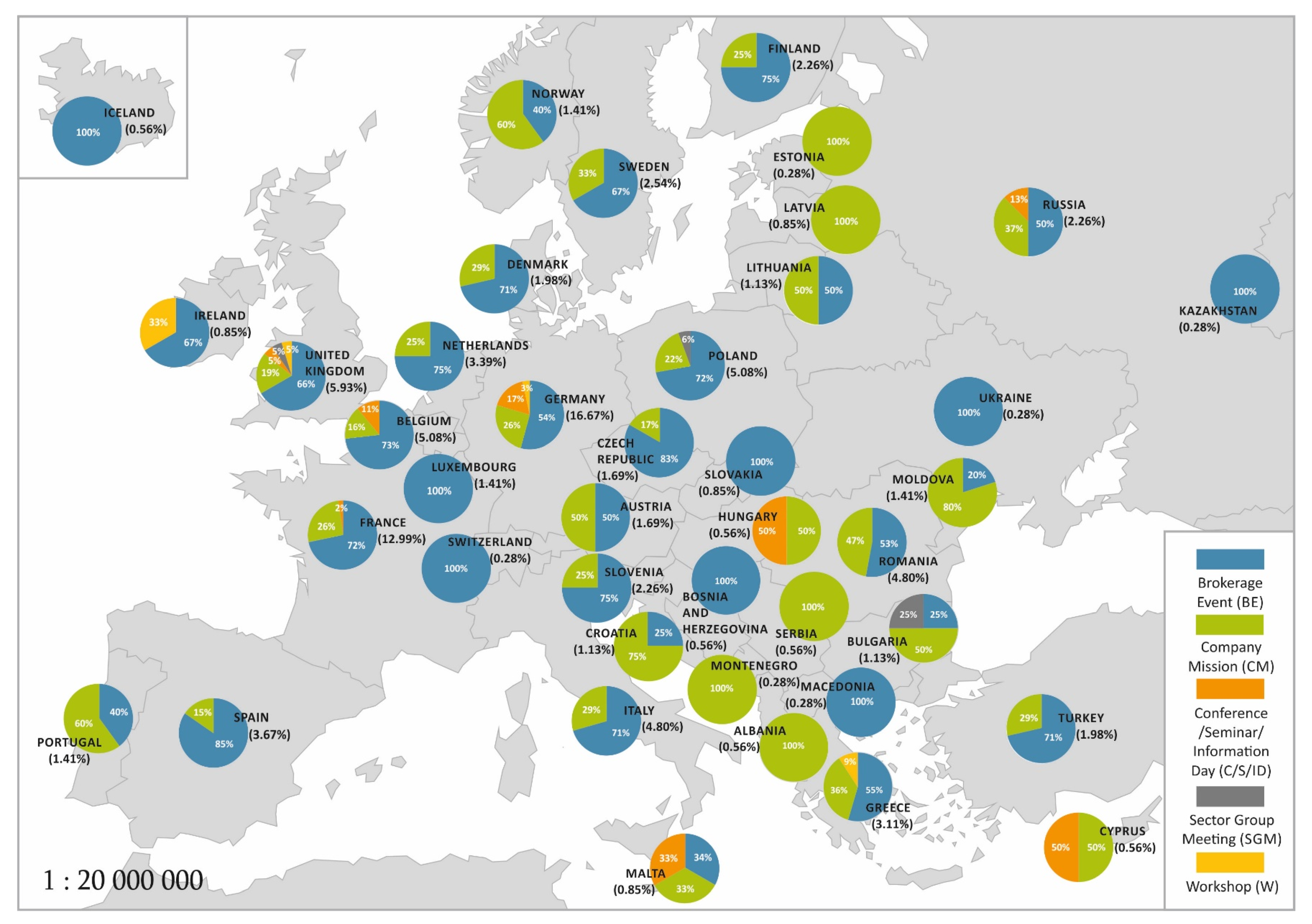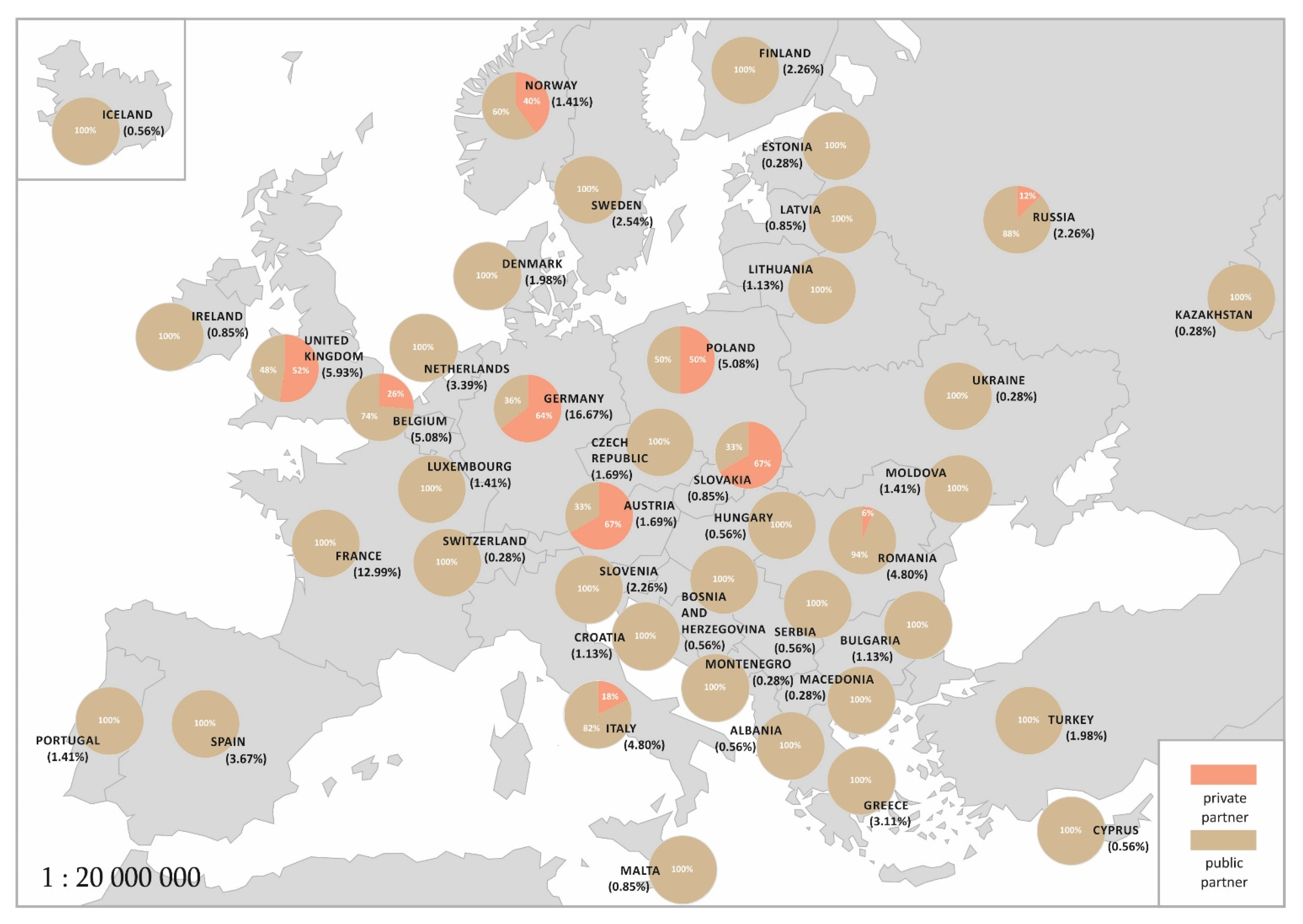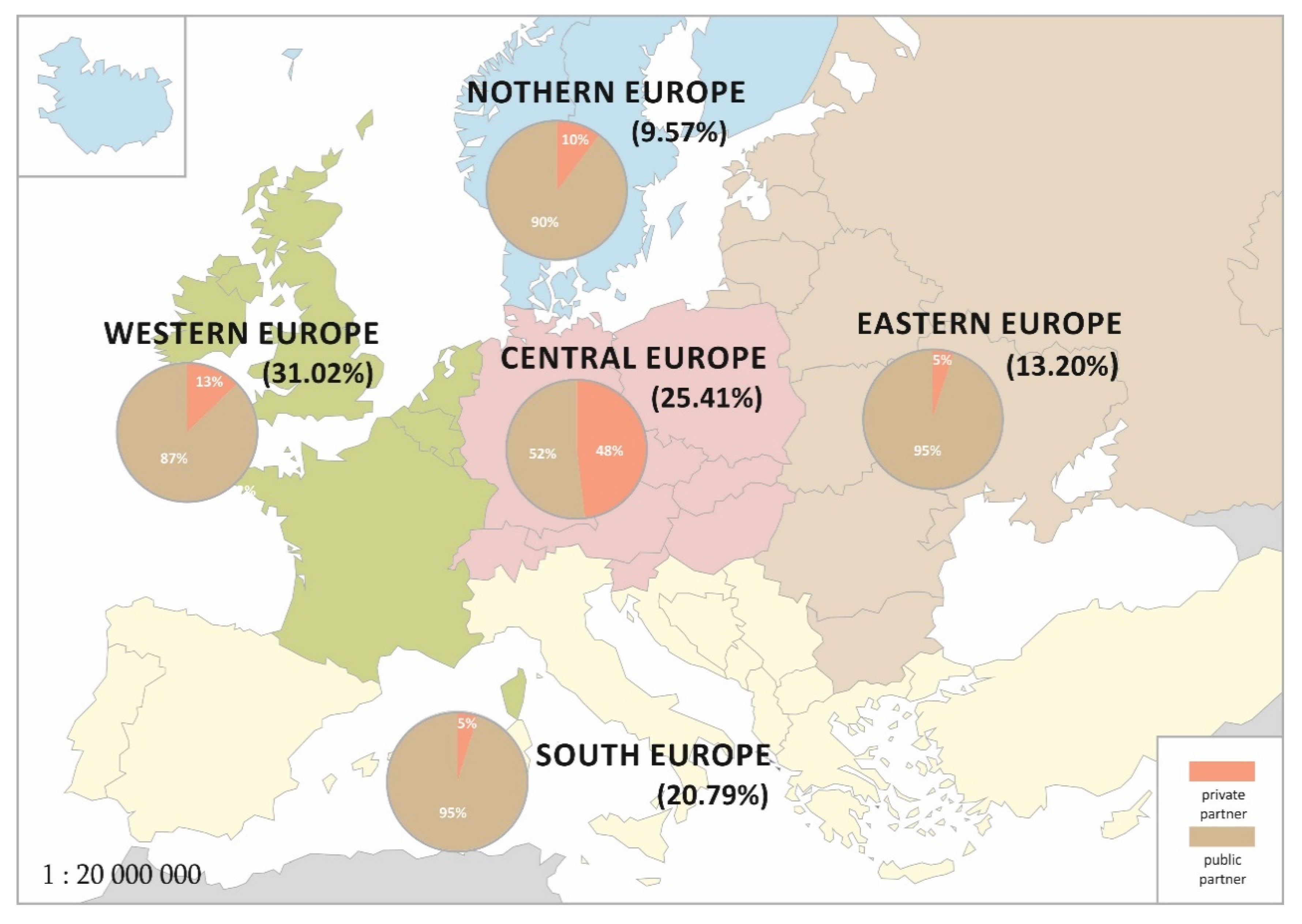Renewable Energy Promotion Instruments Used by Innovation Brokers in a Technology Transfer Network. Case Study of the Enterprise Europe Network
Abstract
1. Introduction
- to present the structure of events used to promote RES in Europe by the Enterprise Europe Network in the years 2017–2018;
- to verify whether the type of promotion instrument used is significantly related to the location of the events organized;
- to research whether the selection of the supporting partner is determined by the organized event’s geographical location.
2. Materials and Methods
- The forms of meetings organized in different parts of Europe are varied.
- In countries from different parts of the European continent, there is a diversity in the selection of an event partner (public or private).
3. Results and Discussions
3.1. Analysis of the Structure of Promotional Instruments in Individual Countries of Respective European Regions
3.2. Analysis of the Structure of Promotional Instruments in Individual Regions of Europe
- Western Europe—Belgium, the Netherlands, Luxembourg, Great Britain, Ireland and France.
- Central Europe—Austria, Czech Republic, Germany, Hungary, Liechtenstein, Poland, Slovakia, Slovenia, and Switzerland.
- Northern Europe—Finland, Iceland, Norway, Sweden, and Denmark.
- Eastern Europe—Belarus, Bulgaria, Estonia, Lithuania, Latvia, Moldova, Romania, Russia, Ukraine and Kazakhstan.
- Southern Europe—Albania, Andorra, Bosnia and Herzegovina, Croatia, Greece, Spain, Macedonia, Malta, Monaco, Portugal, San Marino, Serbia, Montenegro, Turkey, Vatican, and Italy.
3.3. Analysis of the Diversity of Events Per Dominant Partner in Individual Countries and Parts of Europe
4. Conclusions
- Undertake further research aimed at the determinants of choice and effectiveness of individual forms. Defining them would be useful for partner networks, institutions supporting the development of RES and directly, for meeting organizers. Further research could contribute to strengthening cooperation and improving the effectiveness of RES popularization and achieving the ambitious goals set in the EU in this respect.
- Promotion initiatives by brokerage networks in terms of RES technology transfer should stimulate and support national and regional development measures in these areas. They should also promote the exchange of best practices in terms of RES energy production between local and regional development initiatives and activate brokers in innovation networks.
Author Contributions
Funding
Conflicts of Interest
References
- Knockaert, M.; Spithoven, A.; Clarysse, B. The impact of technology intermediaries on firm cognitive capacity additionality. Technol. Forecast. Soc. Chang. 2014, 81, 376–387. [Google Scholar] [CrossRef]
- Lin, H.; Zeng, S.; Liu, H.; Li, C. How do intermediaries drive corporate innovation? A moderated examination. J. Bus. Res. 2016, 69, 4831–4836. [Google Scholar] [CrossRef]
- Howells, J. Intermediation and the role of intermediaries in innovation. Res. Policy 2006, 35, 715–728. [Google Scholar] [CrossRef]
- Sieg, J.H.; Wallin, M.W.; von Krogh, G. Managerial challenges in open innovation: A study of innovation intermediation in the chemical industry. Policy 2010, 40, 281–291. [Google Scholar] [CrossRef]
- Smedlund, A. The roles of intermediaries in regional knowledge systems. J. Intellect. Cap. 2006, 7, 204–222. [Google Scholar] [CrossRef]
- Klerkx, L.; Leeuwis, C. Matching demand and supply in the agricultural knowledge infrastructure: Experiences with innovation intermediaries. Food Policy 2008, 33, 260–276. [Google Scholar] [CrossRef]
- Klerkx, L.; Leeuwis, C. Balancing multiple interests: Embedding innovation intermediation in the agricultural knowledge infrastructure. Technovation 2008, 28, 364–378. [Google Scholar] [CrossRef]
- Edler, J.; Yeow, J. Connecting demand and supply: The role of intermediation in public procurement of innovation. Res. Policy 2016, 45, 414–426. [Google Scholar] [CrossRef]
- Gródek-Szostak, Z.; Szeląg-Sikora, A.; Sikora, J.; Korenko, M. Prerequisites for the cooperation between enterprises and business support institutions for technological development. Business and Non-profit Organizations Facing Increased Competition and Growing Customers’ Demand. In Proceedings of the 16th International Conference, Tomaszowice, Poland, 19–20 June 2017. [Google Scholar]
- Boon, W.P.; Moors, E.H.; Kuhlmann, S.; Smits, R.E. Demand articulation in emerging technologies: Intermediary user organisations as co-producers? Res. Policy 2011, 40, 242–252. [Google Scholar] [CrossRef]
- Gródek-Szostak, Z.; Luc, M.; Szeląg-Sikora, A.; Sikora, J.; Niemiec, M.; Ochoa Siguencia, L.; Velinov, E. Promotion of RES in a Technology Transfer Network. Case Study of the Enterprise Europe Network. Energies 2020, 13, 3445. [Google Scholar] [CrossRef]
- Szeląg-Sikora, A.; Sikora, J.; Niemiec, M.; Gródek-Szostak, Z.; Kapusta-Duch, J.; Kuboń, M.; Komorowska, M.; Karcz, J. Impact of Integrated and Conventional Plant Production on Selected Soil Parameters in Carrot Production. Sustainability 2019, 11, 5612. [Google Scholar] [CrossRef]
- Kapusta-Duch, J.; Szeląg-Sikora, A.; Sikora, J.; Niemiec, M.; Gródek-Szostak, Z.; Kuboń, M.; Leszczyńska, T.; Borczak, B. Health-Promoting Properties of Fresh and Processed Purple Cauliflower. Sustainability 2019, 11, 4008. [Google Scholar] [CrossRef]
- Gródek-Szostak, Z.; Malik, G.; Kajrunajtys, D.; Szeląg-Sikora, A.; Sikora, J.; Kuboń, M.; Niemiec, M.; Kapusta-Duch, J. Modeling the Dependency between Extreme Prices of Selected Agricultural Products on the Derivatives Market Using the Linkage Function. Sustainability 2019, 11, 4144. [Google Scholar] [CrossRef]
- Niemiec, M.; Chowaniak, M.; Sikora, J.; Szeląg-Sikora, A.; Gródek-Szostak, Z.; Komorowska, M. Selected Properties of Soils for Long-Term Use in Organic Farming. Sustainability 2020, 12, 2509. [Google Scholar] [CrossRef]
- Sikora, J.; Niemiec, M.; Tabak, M.; Gródek-Szostak, Z.; Szeląg-Sikora, A.; Kuboń, M.; Komorowska, M. Assessment of the Efficiency of Nitrogen Slow-Release Fertilizers in Integrated Production of Carrot Depending on Fertilization Strategy. Sustainability 2020, 12, 1982. [Google Scholar] [CrossRef]
- Velinov, E.; Petrenko, Y.; Vechkinzova, E.; Denisov, I.; Ochoa Siguencia, L.; Gródek-Szostak, Z. “Leaky Bucket” of Kazakhstan’s Power Grid: Losses and Inefficient Distribution of Electric Power. Energies 2020, 13, 2947. [Google Scholar] [CrossRef]
- Sikora, J.; Niemiec, M.; Szeląg-Sikora, A.; Gródek-Szostak, Z.; Kuboń, M.; Komorowska, M. The Impact of a Controlled-Release Fertilizer on Greenhouse Gas Emissions and the Efficiency of the Production of Chinese Cabbage. Energies 2020, 13, 2063. [Google Scholar] [CrossRef]
- Sikora, J.; Niemiec, M.; Szeląg-Sikora, A.; Gródek-Szostak, Z.; Kuboń, M.; Komorowska, M. The Effect of the Addition of a Fat Emulsifier on the Amount and Quality of the Obtained Biogas. Energies 2020, 13, 1825. [Google Scholar] [CrossRef]
- Shirley, M. Institutions and Development. In Handbook of New Institutional Economics; Meénard, C., Shirley, M., Eds.; Springer: Dordrecht, The Netherlands, 2005. [Google Scholar]
- Sanderink, L.; Nasiritousi, N. How institutional interactions can strengthen effectiveness: The case of multi-stakeholder partnerships for renewable energy. Energy Policy 2020, 141, 111447. [Google Scholar] [CrossRef]
- Sawhney, M.; Prandelli, E.; Verona, G. The power of innomediation. MIT Sloan Manag. Rev. 2003, 44, 77–82. [Google Scholar]
- Verona, G.; Prandelli, E.; Sawhney, M. Innovation and virtual environments: Towards virtual knowledge brokers. Organ. Stud. 2006, 27, 755–788. [Google Scholar] [CrossRef]
- Sapsed, J.; Grantham, A.; De Fillippi, R. A bridge over troubled waters: Bridging organisations and entrepreneurial opportunities in emerging sectors. Res. Policy 2007, 36, 1314–1334. [Google Scholar] [CrossRef]
- Nambisan, S.; Sawhney, M. A buyer’s guide to the innovation bazaar. Harv. Bus. Rev. 2007, 85, 109–118. [Google Scholar]
- Arnold, E.; Clark, J.; Javorka, Z. Impacts of European RTOs: A Study of Social and Economic Impacts of Research and Technology Organisations; Report to European Association of Research and Technology Organisations (EARTO); Technopolis Ltd.: Brighton, UK, 2010. [Google Scholar]
- Tran, Y.; Hsuan, J.; Mahnke, V. How do innovation intermediaries add value? Insight from new product development in fashion markets. R&D Manag. 2011, 41, 80–91. [Google Scholar]
- Landry, R.; Amara, N.; Cloutier, J.S.; Halilem, N. Technology transfer organizations: Services and business models. Technovation 2013, 33, 431–449. [Google Scholar] [CrossRef]
- Erickson, J.D.; Chapman, D. Photovoltaic technology: Markets, economics, and rural development. World Dev. 1995, 23, 1129–1141. [Google Scholar] [CrossRef]
- Rai, V.; Schultz, K.; Funkhouser, E. International low carbon technology transfer: Do intellectual property regimes matter? Glob. Environ. Chang. 2014, 24, 60–74. [Google Scholar] [CrossRef]
- Theodorou, S.; Florides, G.; Tassou, C. The use of multiple criteria decision making methodologies for the promotion of RES through funding schemes in Cyprus, A review. Energy Policy 2010, 38, 7783–7792. [Google Scholar] [CrossRef]
- Krajačić, G.; Duić, N.; Tsikalakis, A.; Zoulias, M.; Caralis, G.; Panteri, E.; da Graca Carvalho, M. Feed-in tariffs for promotion of energy storage technologies. Energy Policy 2011, 39, 1410–1425. [Google Scholar] [CrossRef]
- Haas, R.; Panze, C.; Resch, G.; Ragwitz, M.; Reece, G.; Held, A. A historical review of promotion strategies for electricity from renewable energy sources in EU countries. Renew. Sustain. Energy Rev. 2011, 15, 1003–1034. [Google Scholar] [CrossRef]
- Ragwitz, M.; Huber, C.; Resch, G. Promotion of renewable energy sources: Effects on innovation. Int. J. Public Policy 2007, 2, 32–56. [Google Scholar] [CrossRef]
- Moreno, B.; Lopez, A.J. The Effect of Renewable Energy on Employment. The Case of Asturias (Spain). Renew. Sustain. Energy Rev. 2008, 12, 732–751. [Google Scholar] [CrossRef]
- Ferraro, G.; Iovanella, A. Technology transfer in innovation networks: An empirical study of the Enterprise Europe Network. Int. J. Eng. Bus. Manag. 2017, 9. [Google Scholar] [CrossRef]
- Sagan, D. Event Marketing—Innowacja czy Niedoceniana Forma Promocji? Available online: http://nf.pl/manager/event-marketing-innowacja-czy-niedoceniana-forma-promocji,,53474,82 (accessed on 17 September 2020).
- Ogundele, T.J.; Chow, C.Y.; Zhang, J.D. SoCaST: Personalized event recommendations for event-based social networks: A multi-criteria decision making approach. IEEE Access 2018, 6, 27579–27592. [Google Scholar] [CrossRef]
- Gródek-Szostak, Z.; Luc, M.; Szeląg-Sikora, A.; Niemiec, M.; Kajrunajtys, D. Economic Missions and Brokerage Events as an Instrument for Support. of International Technological Cooperation between Companies of the Agricultural and Food Sector. In Infrastructure and Environment; Springer: Cham, Switzerland, 2019; pp. 303–308. [Google Scholar]
- Europe Countries and Regions. Available online: https://www.worldatlas.com/articles/the-four-european-regions-as-defined-by-the-united-nations-geoscheme-for-europe.html (accessed on 18 October 2020).
- Gródek-Szostak, Z.; Luc, M. Company mission events i brokeage events jako narzędzia wsparcia międzynarodowej współpracy technologicznej. In Zarządzanie Restrukturyzacją: Innowacyjność i Konkurencyjność w Obliczu Zmian; Towarzystwo Naukowe Organizacji i Kierownictwa, Dom Organizatora: Toruń, Poland, 2019; pp. 231–239. [Google Scholar]
- Enterprise Europe Network. Available online: https://een.ec.europa.eu/my/n/sector-groups (accessed on 9 September 2020).
- Citizens’ Participation in the Energiewende. Available online: https://www.cleanenergywire.org/factsheets/citizens-participation-energiewende (accessed on 17 September 2020).






| No. | Promotion Instrument | Characteristic |
|---|---|---|
| 1. | Brokerage Event (BE) | A direct form of searching for a cooperation partner, offering the possibility to exchange information on innovative technologies, new trends, as well as to search for business and technological partners [11], e.g.,:
|
| 2. | Company Mission (CM) | A direct form of reaching the right potential business partner in the natural place of their operation, which allows learning not only about their possibilities but also their immediate business and legal environment [11], np.:
|
| 3. | Conference/Seminar/Information Day (C/S/ID) | Open information meetings, promoting the idea of technological cooperation in a specific sector/industry, e.g.,:
|
| 4. | Sector Group Meeting (SGM) | Meetings of network partners who take up cooperation in order to meet the specific needs of their clients, in a specific sector, e.g., renewable energy, e.g.,:
|
| 5. | Workshop (W) | Open workshop meetings, to prepare for the execution of international technology transfers and internationalization, e.g.,:
|
Publisher’s Note: MDPI stays neutral with regard to jurisdictional claims in published maps and institutional affiliations. |
© 2020 by the authors. Licensee MDPI, Basel, Switzerland. This article is an open access article distributed under the terms and conditions of the Creative Commons Attribution (CC BY) license (http://creativecommons.org/licenses/by/4.0/).
Share and Cite
Gródek-Szostak, Z.; Suder, M.; Kusa, R.; Szeląg-Sikora, A.; Duda, J.; Niemiec, M. Renewable Energy Promotion Instruments Used by Innovation Brokers in a Technology Transfer Network. Case Study of the Enterprise Europe Network. Energies 2020, 13, 5752. https://doi.org/10.3390/en13215752
Gródek-Szostak Z, Suder M, Kusa R, Szeląg-Sikora A, Duda J, Niemiec M. Renewable Energy Promotion Instruments Used by Innovation Brokers in a Technology Transfer Network. Case Study of the Enterprise Europe Network. Energies. 2020; 13(21):5752. https://doi.org/10.3390/en13215752
Chicago/Turabian StyleGródek-Szostak, Zofia, Marcin Suder, Rafał Kusa, Anna Szeląg-Sikora, Joanna Duda, and Marcin Niemiec. 2020. "Renewable Energy Promotion Instruments Used by Innovation Brokers in a Technology Transfer Network. Case Study of the Enterprise Europe Network" Energies 13, no. 21: 5752. https://doi.org/10.3390/en13215752
APA StyleGródek-Szostak, Z., Suder, M., Kusa, R., Szeląg-Sikora, A., Duda, J., & Niemiec, M. (2020). Renewable Energy Promotion Instruments Used by Innovation Brokers in a Technology Transfer Network. Case Study of the Enterprise Europe Network. Energies, 13(21), 5752. https://doi.org/10.3390/en13215752









